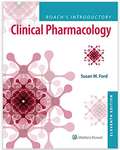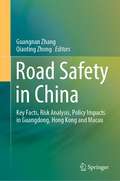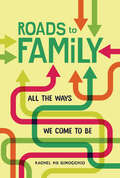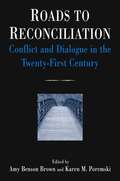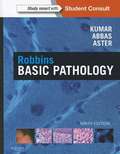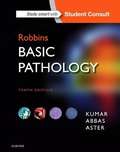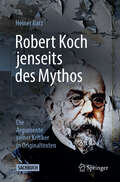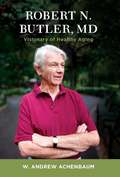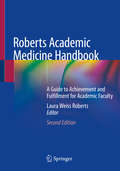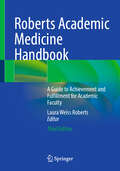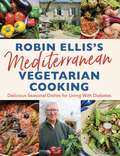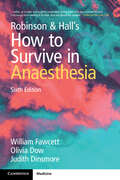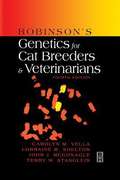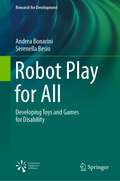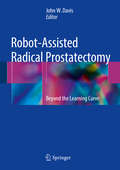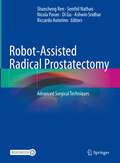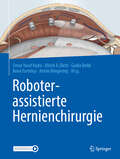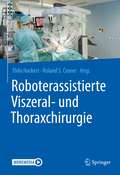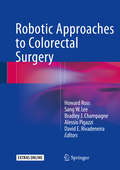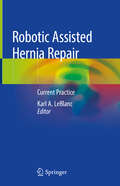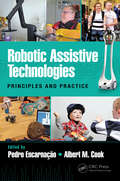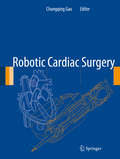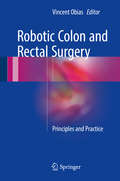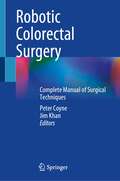- Table View
- List View
Roach's Introductory Clinical Pharmacology
by Susan M. FordPrepare your students for successful practice and NCLEX-PN success with this updated 11th Edition of Roach’s Introductory Clinical Pharmacology. <p><p>Developed by nurses for nurses, this practice-oriented text not only helps students learn about drugs and their effect on real people, but also models how to relay this information to patients. Known for its impeccably accurate drug content, this bestseller focuses on basic principles and the nurse's responsibility in medication management. <p><p>The book’s easy-to-understand writing style combines with empowering online resources, including videos, NCLEX-PN-style review questions, and drug monographs, to help students hone their critical thinking and problem-solving skills as they master one of the most challenging content areas in the curriculum.
Road Safety in China: Key Facts, Risk Analysis, Policy Impacts in Guangdong, Hong Kong and Macau
by Guangnan Zhang Qiaoting ZhongThis book presents comprehensive research and analyses on road traffic safety in China, discussing individual, vehicle, road and environmental factors to improve road safety in the country. It also sheds light on the development of similar (adjusted) measures to reduce traffic violations and/or accident fatalities and injuries, and to promote road safety in other countries and regions. As such, it is a valuable resource for anyone wanting to understand the characteristics and patterns of road traffic safety, the risk factors affecting traffic violations and traffic injuries, as well as road safety policies and practices in China.
Roads to Family: All the Ways We Come to Be
by Rachel HS GinocchioExamine—and appreciate—the many ways in which people can create a family. This informative compendium goes beyond the basics of sexual reproduction to examine the diversity of medical and societal methods people use, including in-vitro fertilization, surrogacy, adoption, and more. Through scientific research, diagrams, and interviews with families, author Rachel Ginocchio provides a thoughtful and thorough examination of the possibilities available.
Roads to Reconciliation: Conflict and Dialogue in the Twenty-first Century
by Amy Benson Brown Karen M. PoremskiUnlike other books on conflict resolution that focus on particular places and moments in history, this original work attempts to understand the process from many different perspectives and in many different contexts - from international political conflicts, to racial and religious struggles within one culture, to the internal conflicts of individuals struggling with the desire for revenge in the wake of 9/11. Designed as a starting point for meaningful dialogue on the elusive concept of reconciliation, the book includes views from Christians and Muslims, scholars and politicians, and draws on religion, psychology, cultural studies, education theory, history, and law.
Robbins Basic Pathology
by Vinay Kumar Abul Abbas Jon AsterRobbins Basic Pathology delivers the pathology knowledge you need, the way you need it, from the name you can trust! This medical textbook’s unbeatable author team helps you efficiently master the core concepts you need to know for your courses and USMLE exams.
Robbins Basic Pathology (Robbins Pathology Ser.)
by Vinay Kumar Abul Abbas Jon AsterPart of the trusted Robbins and Cotran family, Robbins Basic Pathology provides a readable, well-illustrated and concise overview of the principles of human pathology that's ideal for today's busy students. This thoroughly revised edition continues with a strong emphasis on pathogenesis and the clinical features of disease, adding new artwork and more schematic diagrams to further aid in summarizing key pathologic processes and expand the already impressive illustration program. Excellent art program boasts high-quality photomicrographs, gross photos, and radiologic images to supplement the world-class illustrations. Bulleted summary boxes provide quick access to key information and easy review of key concepts. Highlights pathogenesis, morphology, and pathophysiologic content throughout. Includes increased and updated clinical topics. New artwork and more schematic diagrams summarize key pathologic processes. An all-star editorial team enables you to gain a rich understanding of all essential pathology concepts. Student Consult eBook version included with purchase. This enhanced eBook experience allows you to search all of the text, figures, and images from the book on a variety of devices. You'll also access virtual microscope slides, self-assessment questions, additional images, updated pathology case studies, and Targeted Therapy boxes.
Robert Koch jenseits des Mythos: Die Argumente seiner Kritiker in Originaltexten
by Heiner BarzEine neue Sicht auf den berühmten Nobelpreisträger Robert Koch! Robert Koch stand für die Weltgeltung der maßgeblich von ihm entwickelten Bakteriologie in der Medizin. Wenig bekannt ist: Koch, der als Entdecker des Tuberkulose-Erregers mit dem Nobelpreis geehrte wurde, hat kein einziges funktionierendes Heilmittel entwickelt! Im Gegenteil: Das von ihm mit großem PR-Aufwand und hohen Gewinnerwartungen vermarktete Tuberkulose Medikament „Tuberkulin“ war ein gigantischer Fehlschlag. Auch seine medizinethisch hochproblematischen experimentellen Injektionen von arsenhaltigem „Atoxyl“ in Ostafrika führten statt Besserung vor allem zu Lähmungen und Tod. Dieses Buch versammelt Originaltexte bedeutender zeitgenössischer Mediziner. All diese sprachen sich aus toxikologischer, klinischer, pharmakologischer, naturheilkundlicher oder epidemiologischer Perspektive gegen Kochs Tuberkulin im Besonderen und gegen die biochemische Verengung der ärztlichen Praxis im Allgemeinen aus. Kochs Ansatz wurde nämlich bereits zu Lebzeiten von führenden Medizinern kritisiert, die jedoch systematisch als Fortschrittsfeinde diffamiert wurden. Eine interessante Lektüre für alle, die sich für die Geschichte der Wissenschaft und die Dynamik wissenschaftlicher Kontroversen interessieren. Debatten, die bis heute nachwirken!
Robert N. Butler, MD: Visionary of Healthy Aging
by W. Andrew AchenbaumRobert Neil Butler (1927–2010) was a scholar, psychiatrist, and Pulitzer Prize–winning author who revolutionized the way the world thinks about aging and the elderly. One of the first psychiatrists to engage with older men and women outside of institutional settings, Butler coined the term "ageism" to draw attention to discrimination against older adults and spent a lifetime working to improve their status, medical treatment, and care.Early in his career, Butler seized on the positive features of late-life development—aspects he documented in his pathbreaking research on "healthy aging" at the National Institutes of Health and in private practice. He set the nation's age-based health care agenda and research priorities as founding director of the National Institute on Aging and by creating the first interprofessional, interdisciplinary department of geriatrics at New York City's Mount Sinai Hospital. In the final two decades of his career, Butler created a global alliance of scientists, educators, practitioners, politicians, journalists, and advocates through the International Longevity Center. A scholar who knew Butler personally and professionally, W. Andrew Achenbaum follows this pioneer's significant contributions to the concept of healthy aging and the notion that aging is not synonymous with physical and mental decline. Emphasizing the progressive aspects of Butler's approach and insight, Achenbaum affirms the ongoing relevance of his work to gerontology, geriatrics, medicine, social work, and related fields.
Roberts Academic Medicine Handbook: A Guide to Achievement and Fulfillment for Academic Faculty
by Laura Weiss RobertsThis authoritative, updated and expanded title serves as the gold-standard resource to assist physicians, clinicians, and scientists in developing effective and satisfactory careers in academic medicine. Covering such critical topics as finding one's path in academic medicine, getting established at an institution, approaching work with colleagues, writing and reviewing manuscripts, conducting empirical research, developing administrative skills, advancing one's academic career, and balancing one's professional and personal life, each chapter includes valuable career pointers and best practice strategies, as well as pithy words to the wise and questions to ask a mentor or colleague. Building on the success of the first edition, the Roberts Academic Medicine Handbook: A Guide to Achievement and Fulfillment for Academic Faculty, 2nd Edition includes new case examples and updated references, as well as many new and timely chapters on topics such as public speaking, working with the media, working with community-based organizations, philanthropy, and finding meaning and a sense of belonging in one's work. The Roberts Academic Medicine Handbook, 2nd Edition is an indispensable resource for all professionals entering or already established in academic medicine who wish to achieve a fulfilling career.
Roberts Academic Medicine Handbook: A Guide to Achievement and Fulfillment for Academic Faculty
by Laura Weiss RobertsThis third edition has been fully updated and expanded, including seventy-three chapters, a dozen of which are new, to support the professional development and success of faculty in the field of academic medicine. Previous editions of Roberts Academic Medical Handbook are regarded as gold-standard resources that guide health professionals, including clinicians, scientists, and learners, in navigating their careers in academic medicine. Section One covers the critical topic of approaching the path of academic medicine, with emphasis on how to build your foundation for a successful career. This section includes two new chapters on contemporary issues faced by new professionals: how to avoid imposter syndrome and how to stay focused. Section Two builds upon this foundation and includes three new practical chapters that will relay to the reader how to craft an effective personal statement, teach in busy clinical settings, and approach board certification and recertification. Section Three examines best practices for working well and effectively with colleagues and includes a new chapter on how to be one&’s best self-advocate in academic settings. Following this, Section Four offers constructive guidance on key competencies for academic faculty, such as preparing book proposals, writing manuscripts, and reviewing manuscripts. Section Five discusses how to conduct empirical studies and includes a new chapter on how to approach medical education research. Section Six includes chapters on developing administrative skills, including best practices in faculty searches and how to work collaboratively with human resources. The book closes with a final section that discusses advancing your career and work-life balance, featuring three new chapters. Roberts Academic Medicine Handbook, 3rd Edition will be an indispensable resource for all professionals entering the field or mentoring others who are seeking fulfillment through a career in academic medicine.
Robin Ellis's Mediterranean Vegetarian Cooking: Delicious Seasonal Dishes for Living Well with Diabetes
by Robin EllisA food lover's guide to eating well with diabetes. Poldark star Robin Ellis's Mediterranean-inspired vegetarian recipes are delicious and suitable for the entire family and for entertaining friends, with no sacrifice of taste or quality.Mediterranean cuisine is among the healthiest in the world and a vegetarian diet has been proven to be particularly health-giving for people who have diabetes. In this book British actor Robin Ellis shares his lifetime collection of healthy and simple vegetarian recipes especially selected and adapted for people wishing to control or prevent Types 2 diabetes. Diagnosed with Type 2 diabetes himself, Robin explains the strategic changes he made - in what he eats and how he prepares his food - that allowed him to bring his glucose levels down sufficiently to avoid taking medication for six years. Robin's recipes show how you can cook and eat delicious vegetarian food without recourse to carb-heavy pastries or potatoes, nor to substitutes such as Quorn or soya, which are not traditional staples of the Mediterranean diet. This is a book about real food and a way of living with diabetes that need not mean you can no longer look forward to breakfast, lunch and dinner - Robin does every day!This fully illustrated book contains photographs, not only of the recipes but of beautiful, rural southwestern France, where Robin lives and leads sell-out cooking workshops focused on simple, delicious and healthy Mediterranean cuisine, making the most of all the fresh local ingredients available.
Robin Ellis's Mediterranean Vegetarian Cooking: Delicious Seasonal Dishes for Living Well with Diabetes
by Robin EllisA food lover's guide to eating well with diabetes. Poldark star Robin Ellis's Mediterranean-inspired vegetarian recipes are delicious and suitable for the entire family and for entertaining friends, with no sacrifice of taste or quality.Mediterranean cuisine is among the healthiest in the world and a vegetarian diet has been proven to be particularly health-giving for people who have diabetes. In this book British actor Robin Ellis shares his lifetime collection of healthy and simple vegetarian recipes especially selected and adapted for people wishing to control or prevent Types 2 diabetes. Diagnosed with Type 2 diabetes himself, Robin explains the strategic changes he made - in what he eats and how he prepares his food - that allowed him to bring his glucose levels down sufficiently to avoid taking medication for six years. Robin's recipes show how you can cook and eat delicious vegetarian food without recourse to carb-heavy pastries or potatoes, nor to substitutes such as Quorn or soya, which are not traditional staples of the Mediterranean diet. This is a book about real food and a way of living with diabetes that need not mean you can no longer look forward to breakfast, lunch and dinner - Robin does every day!This fully illustrated book contains photographs, not only of the recipes but of beautiful, rural southwestern France, where Robin lives and leads sell-out cooking workshops focused on simple, delicious and healthy Mediterranean cuisine, making the most of all the fresh local ingredients available.
Robinson and Hall's How to Survive in Anaesthesia
by William Fawcett Olivia Dow Judith DinsmoreThe initial months working as a trainee anaesthetist are daunting, with a wealth of new drugs, terminology, anaesthetic equipment, and practical procedures to master. This essential guide, now in its sixth edition, provides doctors and clinical staff with a clear introduction on the delivery of safe anaesthesia from day one. Fully updated and split into four key parts for quick consultation, it covers the airway and anaesthetic equipment, and offers advice on how to manage common crises and emergencies such as cardiac arrest, haemorrhage, and blood transfusion. Proceeding parts explore subspecialties and provide information on intensive care and perioperative medicine. Thoroughly revised and updated to reflect recent changes in anaesthesia, and including new chapters on obstetric anaesthesia, common regional nerve blocks, and emergency laparotomy. Written in an accessible style, it is an essential resource for learning the safe fundamentals of anaesthetic practice for trainee anaesthetists and clinical staff working alongside anaesthetists.
Robinson's Genetics for Cat Breeders and Veterinarians
by Carolyn M. Vella Roy Robinson John J. McGonagle Lorraine M. Shelton Terry W. Stanglein<p>The field of genetics has changed considerably since the first edition of Genetics for Cat Breeders was published in 1971. For decades the discussion of genetics was limited to observations of populations but now geneticists are beginning to look at the actual molecular mechanisms behind the traits and diseases seen in the cat. <p>Continuing the pioneering work of the late Roy Robinson, Carolyn Vella and her team of experts have significantly expanded the scope of previous editions to produce a work which is now of equal benefit to both veterinary surgeons and cat breeders. Their aim has been to make the book more accessible and understandable whilst providing an impartial look at sometimes controversial and complex issues. <p>The book retains the most important information published in previous editions and also incorporates some of the continuing work done by Roy Robinson prior to his death. A considerable amount of new information has been added in order to provide both breeders and veterinarians with the broadest possible range of information. The authors have not only reviewed the traditional sources of scientific literature and recently published studies, but have also conducted interviews with veterinarians, researchers and breeders. <p> <li>The 4th edition of Roy Robinson's established text on cat genetics has been updated by a team of specialists to reflect a decade of changes and advances in genetic research <li>The authorship now includes a practicing veterinarian as well as experienced cat breeders, thus making this new edition useful at both veterinary and breeder levels <li>New technical and historical appendices contain important reference material and a glossary has been added for ease of reference</li> </p>
Robot Play for All: Developing Toys and Games for Disability (Research for Development)
by Andrea Bonarini Serenella BesioThis book presents a comprehensive guide to the design of playing robots and the related play experiences. Play is a natural activity for building and improving abilities, and it reveals important particularly for persons with disabilities. Many social, physical and cultural factors may hinder children with disabilities from fully enjoying play as their peers. Autonomous robots with specific characteristics can enhance the ludic experience, having implications for the character of the play and presenting opportunities related to autonomy and physical movement, the very nature of robots. Their introduction into play thus provides everybody, and in particular persons with disabilities, new possibilities for developing abilities, improving general status, participating in social contexts, as well as supporting professionals in monitoring progress. This book presents a framework for the design of playful activities with robots, developed over 20 years’ experience at AIRLab - POLIMI. Part 1 introduces the play concepts and characteristics, and research results about play of children with different kinds of impairments. Part 2 focuses on implementing robots able to play. The design of playful activities is discussed, as well as the necessary characteristics for them to be useful in both general play and activities involving disability-related limitations. In Part 3, the defined framework is used to analyze possibilities involving robots available on the toy market, robots developed at research labs, and robots to be developed in the next future. The aim of the book is to give developers, caregivers, and users a set of methodological tools for selecting, exploring, and designing inclusive play activities where robots play a central role.
Robot-Assisted Radical Prostatectomy
by John W. DavisThis book addresses knowledge gaps in RARP in 3 key sections: 1) Step-by-step approach including multiple technique options and innovations, 2) Patient selection, safety, outcomes, and 3) Preparing the patient for surgery. The order is more based upon knowledge priority rather than a chronologic sequence in which part 3 would go first. Part two allows more summary and commentary on evidence and part three allows some creative content that is otherwise hard to find in one place--medical evaluations, imaging, clinical trials, patient education, etc. This textbook emphasizes content for the advanced skills surgeon in that multiple techniques are presented as well as state of the art evidence. The learning curve is addressed and the authors clarify how this text is useful for learners. The caveat is that they should be careful in patient selection and stick with what their mentors are showing them. With experience, they can then branch out into the many techniques presented here. Robot-Assisted Radical Prostatectomy: Beyond the Learning Curve will also have cross-over appeal for surgical assistants, physician assistants, nurses, and anyone else involved in the surgical care of prostate cancer.
Robot-Assisted Radical Prostatectomy: Advanced Surgical Techniques
by Riccardo Autorino Shancheng Ren Senthil Nathan Nicola Pavan Di Gu Ashwin SridharThis book comprehensively covers the techniques available for robot- assisted prostatectomy. Chapters feature detailed descriptions of how to successfully perform a variety of relevant techniques including the reconstruction of continence mechanisms and the use of the transperitoneal RALP anterior approach. Potential complications, preoperative and postoperative management strategies are also discussed, enabling the reader to develop a thorough understanding of how to apply a range of relevant methodologies into their day-to-day clinical practice and avoid commonly encountered pitfalls.Robot-Assisted Radical Prostatectomy: Advanced Surgical Techniques provides a practically applicable resource for all practicing and trainee urologists seeking a detailed overview of the latest advances in robot-assisted surgical procedures and current management strategies applicable to prostatectomy.
Roboterassistierte Hernienchirurgie
by Omar Yusef Kudsi Ulrich A. Dietz Guido Beldi Armin Wiegering René FortelnyMöglichkeiten und Grenzen der roboterassistierten Hernienchirurgie werden in diesem Buch von einem internationalen Autorenteam in allen Facetten dargestellt. Im Mittelpunkt stehen Schritt-für-Schritt-Beschreibungen der einzelnen Eingriffe bei unterschiedlichen Indikationen und die detaillierte Beschreibung der anatomischen Verhältnisse, wie sie sich beim roboterassistierten Vorgehen dem Operateur zeigen. Zahlreiche, eigens für das Buch erstellte Zeichnungen und Operationsfotografien veranschaulichen die Darstellung und werden durch insgesamt 15 Videos zu den Operationsverfahren ergänzt, die aus dem Buch mit der MoreMedia-App des Verlages aufgerufen werden können. Weitere Kapitel gehen auf die patientenbezogenen und wissenschaftlichen Grundlagen ein und betrachten die Verfahren im gesellschaftlichen und ökonomischen Kontext.
Roboterassistierte Viszeral- und Thoraxchirurgie
by Thilo Hackert Roland S. CronerDie Möglichkeiten, die die Anwendung der Robotersysteme für die wichtigsten Indikationsbereiche in der Viszeral- und Thoraxchirurgie bietet, aber auch ihre Limitationen werden fundiert und detailliert von erfahrenen Experten beschrieben: Patientenlagerung, Zugang und schrittweise Durchführung der Operationen, Ergebnisse und Vergleich mit konventionell laparoskopischen und offenen Operationen, postoperatives Management, Lernkurve der Operateure, Vor- und Nachteile der roboterassistierten Verfahren. Zahlreiche Schemata und Fotografien veranschaulichen das operative Vorgehen. In einem eigenen Kapitel sind die Angebote für Ausbildung und Training der Operateure dargestellt; abschließend wird ein Ausblick auf absehbare Weiterentwicklungen gegeben.
Robotic Approaches to Colorectal Surgery
by Sang Lee Howard Ross Bradley J. Champagne Alessio Pigazzi David E. RivadeneiraThis book examines the considerations, drawbacks, and advancements minimally invasive techniques have provided in the evaluation, management, and outcomes across a broad range of colorectal disease and procedures. For some readers of this book, a minimally invasive approach to colorectal disease may add a new dimension to the management of these patients. For others, it is the opportunity to learn helpful tips, specifics about a certain procedure, or to fine tune what has already become a routine part of their practice. Even if you have successfully overcome many of the technical challenges of minimally invasive surgery, the preoperative evaluation, perioperative decision-making, and management of postoperative complications can be demanding and consuming. Wherever you may be on this spectrum, Robotic Approaches to Colorectal Surgery is a useful resource to surgeons.
Robotic Assisted Hernia Repair: Current Practice
by Karl A. LeBlancThis book provides a guide to procedures and techniques related to robotic hernia repair. Sections covering inguinal, incisional, and diaphragmatic hernias are included. Each section will cover the setup of the operating room and the management of adverse events specific to the hernia. The steps involved in performing an operation and key components to a successful repair are also covered The book aims to cover recent technology and updates related to robotic hernia repair. Robotic Assisted Hernia Repair is relevant to robotic hernia surgeons, fellows training in minimally invasive surgery, and general surgical residents.
Robotic Assistive Technologies: Principles and Practice (Rehabilitation Science in Practice Series)
by Pedro Encarnação Albert CookThis book contains a comprehensive overview of all current uses of robots in rehabilitation. The underlying principles in each application are provided. This is followed by a critical review of the technology available, of the utilization protocols, and of user studies, outcomes, and clinical evidence, if existing. Ethical and social implications of robot use are also discussed. The reader will have an in depth view of rehabilitation robots, from principles to practice.
Robotic Cardiac Surgery
by Changqing GaoRobotic Cardiac Surgery is a comprehensive guide to robotic/totally endoscopic cardiac surgery. The book is intended to provide in-depth information regarding the history of robotic surgical systems, their components and principles. It emphasizes patient selection, perioperative management, anesthesia considerations and management, operative techniques and management, postoperative care and results. Extensive, detailed photographs and illustrations of different kinds of robotic surgery are also included. It provides cardiac surgeons, cardiac anesthesiologists, and perfusionists with a comprehensive review of current robotic cardiac surgeries and related knowledge. Changqing Gao, MD, is a professor at the Department of Cardiovascular Surgery, PLA General Hospital, Beijing, China.
Robotic Colon and Rectal Surgery
by Vincent ObiasThe initial chapters discuss the start of minimally invasive surgery and robotics. Subsequent chapters address starting up a robotics program and incorporating robotics into ones practice. The textbook next centers on specific robotic techniques or robotic management of certain disease processes. These chapters are written by experts in the fields and include multiple tables, illustrations, and videos describing the techniques where applicable. Each chapter also discusses the current literature. The final chapters focus on the future of robotics, cost of robotics, and include other possible future platforms and as well as the new FDA approved Xi and SP Intuitive surgical platforms. Robotic Colon and Rectal Surgery: Principles and Practice presents the first in-depth, cohesive and comprehensive approach to all aspects of robotic colorectal surgery.
Robotic Colorectal Surgery: Complete Manual of Surgical Techniques
by Peter Coyne Jim KhanThis book provides a concise overview of the robotic techniques applicable to colorectal surgery. Initially, it describes how to set-up an operating room from an ergonomics perspective. Detailed guidance is then provided on how to apply robotic platforms to the rectum, colon and abdominal wall. Emphasis is placed on describing the latest procedures and how to utilize them in a particular scenario. Instructional picture material and tips and tricks from world leading experts contain tips on how to successfully perform many of the techniques covered, enabling the reader to systematically develop a detailed knowledge of the methodology and how to potentially troubleshoot any issues that may arise.Robotic Colorectal Surgery: Complete Manual of Surgical Techniques describes how to apply the latest robotic techniques in everyday colorectal surgery practice, making it an indispensable resource for trainee and practicing surgeons.
